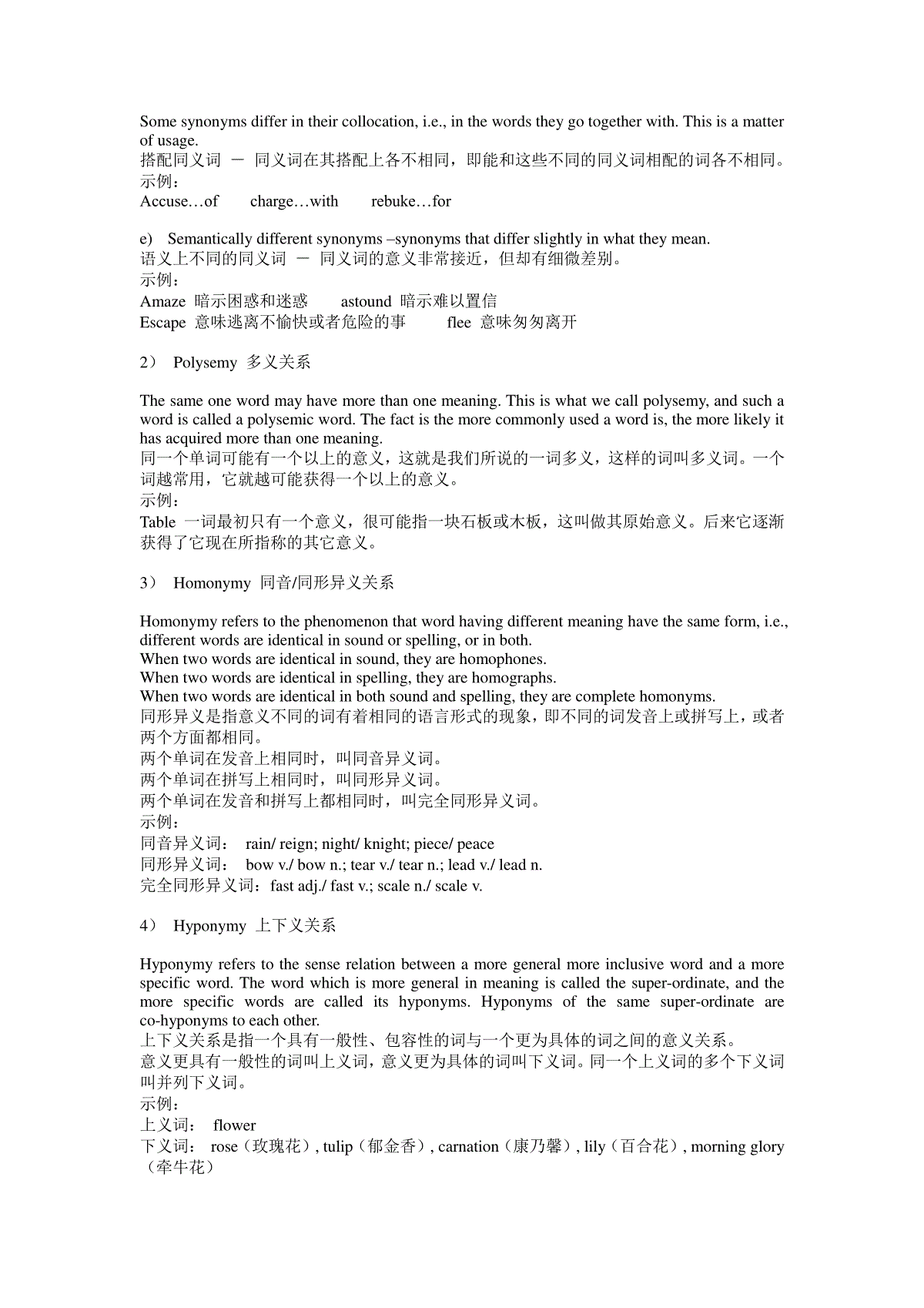Chapter5Semantics语义学1.Whatissemantics?什么是语义学?Semanticscanbesimplydefinedasthestudyofmeaninginlanguage.语义学可定义为对语言意义的研究。2.Someviewsconcerningthestudyofmeaning语义研究的几种主要理论1)Thenamingtheory命名论ItwasproposedbytheancientGreekscholarPlato.Accordingtothistheory,thelinguisticformsorsymbols,inotherwords,thewordsusedinalanguagearetakentobelabelsoftheobjectstheystandfor.Sowordsarejustnamesorlabelsforthings.命名论是最原始的语义理论,是古希腊学者柏拉图提出的。该理论把词看作是该词所指事物的名称或标记。2)Theconceptualistview意念论Theconceptualistviewholdsthatthereisnodirectlinkbetweenalinguisticformandwhatitrefersto;rather,intheinterpretationofmeaningtheyarelinkedthroughthemediationofconceptsinthemind.意念论认为,语言形式及其所代表的对象之间(即语言与现实世界之间)没有直接联系;确切地说,在理解语义时,是通过大脑中存在意念这一中介物来联系的。3)Contextualism语境论Contextualismisbasedonthepresumptionthatonecanderivemeaningfromorreducemeaningtoobservablecontexts.Twokindsofcontextarerecognized:thesituationalcontextandthelinguisticcontext.语境论以这样的假设为基础:人们可以从显而易见的语境中推知或归纳出语义。语境有两种:情景语境和语言语境。语境论认为语言的意义离不开使用语言的语境,语义不是抽象的,它存在于语境之中,它来自语境,取决于语境。4)Behaviorism行为主义论Behavioristsattemptedtodefinethemeaningofalanguageformasthe“situationinwhichthespeakeruttersitandtheresponseitcallsforthinthehearer.”Thistheory,somewhatclosetocontextualism,islinkedwithpsychologicalinterest.语义的行为主义论和语义的语境论有相似之处,它也把语义放到语境中去研究,但它更注重人的心理活动,认为语言的意义存在于语言使用者在交际过程中对听到话语的反应。3.Senseandreference意义和所指Theyaretworelatedbutdifferentaspectsofmeaning.它们是词汇意义的既相互联系又有所不同的两个方面。1)Senseisconcernedwiththeinherentmeaningofthelinguisticform.Itisthecollectionofallthefeaturesofthelinguisticform;itisabstractandde-contextualized.Itistheaspectofmeaningdictionarycompliersareinterestedin.意义关心的是语言形式的内在意义。它是语言形式所有特征的总和,它是抽象且脱离语境的。它是词典编写者们所感兴趣的语义方面。简单地说,意义是词汇内在的,抽象的,游离于语境之外的意义。2)Referencemeanswhatalinguisticformreferstointhereal,physicalworld;itdealswiththerelationshipbetweenthelinguisticelementandnon-linguisticworldofexperience.所指是语言形式在现实世界中所指称的东西;涉及语言成分和非语言的经验世界的关系。简单地说,所指是词汇在特定的语境中所指称的具体事物。4.Majorsenserelations主要意义关系1)Synonymy同义关系Synonymyreferstothesamenessorclosesimilarityofmeaning.Wordsthatarecloseinmeaningarecalledsynonyms.同义现象指的是语义的相同或相近。词义相近的词叫同义词。Accordingtothewaytheydiffer,synonymscanbedividedintothefollowinggroups:a)Dialectalsynonyms–synonymsusedindifferentregionaldialects.BritishEnglishandAmericanEnglisharethetwomajorgeographicalvarietiesoftheEnglishlanguage.方言同义词-用在不同地域方言中的同义词。英国英语和美国英语是英语的两大地理变体。示例:英国英语美国英语AutumnfallLiftelevatorFlatdepartmentWindscreenwindshieldTorchflashlightb)Stylisticsynonyms–synonymsdifferinginstyle.Wordshavingthesamemeaningmaydifferinstyle,ordegreeofformality.Inotherwords,somewordstendtobemoreformal,otherscasual,andstillothersneutralinstyle.文体同义词-在文体上有差异的同义词。有同样意义的词可能在文体上,或者在正式程度上有所不同。也就是说,有些往往比较正式,有些比较随意,有些在问题上则是中性的。示例:Oldman,daddy,dad,father,maleparentStart,begin,commenceKid,child,offspringc)SynonymsthatdifferintheiremotiveorevaluativemeaningTherearewordsthatbearthesamemeaningbutexpressdifferentemotionsoftheuser,indicatingtheattitudeorbiasoftheusertowardwhatheistalkingabout.情感意义或评价意义有所不同的同义词。有着相同的意义却表达了使用者的不同情感的词语,这些词暗示使用者对他所谈论的事情的态度或倾向。示例:Collaborator合作者/Accomplice同谋者,帮凶Like,love,admire,adore,worshipEconomical,frugal,thrifty,mean,miserly,stingyd)Collocationalsynonyms–synonymsdifferingintheircollocation.Somesynonymsdifferintheircollocation,i.e.,inthewordstheygotogetherwith.Thisisamatterofusage.搭配同义词-同义词在其搭配上各不相同,即能和这些不同的同义词相配的词各不相同。示例:Accuse…ofcharge…withrebuke…fore)Semanticallydifferentsynonyms–synonymsthatdifferslightlyinwhattheymean.语义上不同的同义词-同义词的意义非常接近,但却有细微差别。示例:Amaze暗示困惑和迷惑astound暗示难以置信Escape意味逃离不愉快或者危险的事flee意味匆匆离开2)Polysemy多义关系Thesameonewordmayhavemorethanonemeaning.Thisiswhatwecallpolysemy,andsuchawordiscalledapolysemicword.Thefactisthemorecommonlyusedawordis,themorelikelyithasacquiredmorethanonemeaning.同一个单词可能有一个以上的意义,这就是我们所说的一词多义,这样的词叫多义词。一个词越常用,它就越可能获得一个以上的意义。示例:Table一词最初只有一个意义,很可能指一块石板或木板,这叫做其原始意义。后来它逐渐获得了它现在所指称的其它意义。3)Homonymy同音/同形异义关系Homonymyreferstothephenomenonthatwordhavingdifferentmeaninghavethesameform,i.e.,differentwordsareidenticalinsoundorspelling,orinboth.Whentwowordsareidenticalinsound,theyarehomophones.Whentwowordsareidenticalinspelling,theyarehomographs.Whentwowordsareidenticalinbothsoundandspelling,theyarecompletehomonyms.同形异义是指意义不同的词有着相同的语言形式的现象,即不同的词发音上或拼写上,或者两个方面都相同。两个单词在发音上相同时,叫同音异义词。两个单词在拼写上相同时,叫同形异义词。两个单词在发音和拼写上都相同时,叫完全同形异义词。示例:同音异义词:rain/reign;night/knight;piece/peace同形异义词:bowv./bown.;tearv./tearn.;leadv./leadn.完全同形异义词:fastadj./fastv.;scalen./scalev.4)Hyponymy上下义关系Hyponymyreferstothesenserelationbetweenamoregeneralmoreinclusivewordandamorespecificword.Thewordwhichismoregeneralinmeaningiscalledthesuper-ordinate,andthemorespecificwordsarecalleditshyponyms.Hyponymsofthesamesuper-ordinateareco-hyponymstoeachother.上下义关系是指一个具有一般性、包容性的词与一个更为具体的词之间的意义关系。意义更具有一般性的词叫上义词,意义更为具体的词叫下义词。同一个上义词的多个下义词叫并列下义词。示例:上义词:flower下义词:rose(玫瑰花),tulip(郁金香),carnation(康乃馨),lily(百合花),morningglory(牵牛花)上义词:animal下义词:dog,cat,tiger,lion,wolf,elephant,fax,bear5)Antonymy反义关系Thetermantonymyisusedforoppositenessofmeaning,wordsthatareoppositeinmeaningareantonyms.反义关系用以指意义的相反。意义上相反的词叫反义词





 三七文档所有资源均是用户自行上传分享,仅供网友学习交流,未经上传用户书面授权,请勿作他用。
三七文档所有资源均是用户自行上传分享,仅供网友学习交流,未经上传用户书面授权,请勿作他用。
本文标题:语言学第五章要点
链接地址:https://www.777doc.com/doc-7366950 .html